
If you’re like most people, you probably want to eat healthy foods that are low in pesticides. The Environmental Working Group (EWG) has put together a list of the “Dirty Dozen” and the “Clean Fifteen” to help consumers make informed choices about the produce they buy. The Dirty Dozen includes fruits and vegetables with the highest levels of pesticides, while the Clean Fifteen contains produce with the lowest levels of pesticides.
The Dirty Dozen include:
- Strawberries
- Spinach
- Kale, collard & mustard greens
- Nectarines
- Apples
- Grapes
- Bell and hot peppers
- Cherries
- Peaches
- Pears
- Celery
- Tomatoes
These fruits and vegetables are more likely to be contaminated with pesticides because they have thin skins or are grown in areas where pesticides are commonly used.
The Clean Fifteen includes:
- Avocados
- Sweet corn
- Pineapples
- Onions
- Papaya
- Sweet peas
- Asparagus
- Honeydews
- Kiwis
- Cabbage
- Mushrooms
- Cantaloupes
- Mango
- Watermelon
- Sweet Potatoes
These fruits and vegetables have thick skins or are grown in areas where pesticides are not commonly used, so they are less likely to be contaminated with pesticides.
So, what does this mean for you? If you’re concerned about pesticides, try to buy organic versions of the Dirty Dozen. And if you’re on a budget, don’t worry too much about pesticides on the Clean Fifteen – just focus on buying fresh fruits and vegetables in general. Eating a variety of fruits and vegetables is the best way to get the nutrients your body needs!







